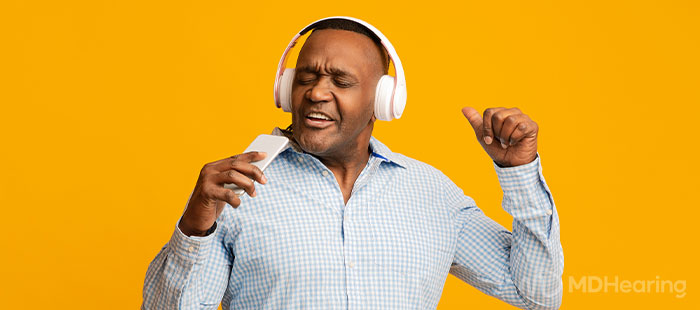Many people enjoy or need to wear other accessories around their ears, and when the need for hearing aids emerges, you might wonder if they will fit with your glasses, nasal cannula, mask, headphones, or other items you might have around your ears. Hearing aid glasses that combine glasses and hearing aids have been around for decades, and new versions promise better functionality, but for most people wearing hearing aids and glasses at the same time is the norm.
There are three common types of hearing aids:
-
Behind-the-ear (BTE) hearing aid
-
Receiver-in-the-canal (RIC) hearing aid
Both BTEs and RICs rest behind the ear, so for the purpose of this article, we will consider a RIC a behind-the-ear style. With these types of hearing aids, the sound travels to the ear canal through either a thin, clear tubing or a receiver wire. Whereas ITEs fit entirely in the bowl of your ear or ear canal without any wires, tubing, or anything else behind the ear.
Wearing glasses and other accessories is particularly a concern for those who wear behind-the-ear hearing aids, so we will mostly focus on BTEs in this article.
Wearing Hearing Aids and Glasses
According to The Vision Council, nearly 64% of Americans wear prescription glasses. Fortunately, many people wear glasses and hearing aids at the same time without issue.
Here are the steps for behind-the-ear hearing aids:
-
Put your glasses on.
-
Put the hearing aid on, placing the hearing aid body between your glasses and your outer ear.
That’s it—no special accessories needed. The hearing aids should fit snugly and comfortably. If you’re the type of person who regularly removes and replaces your glasses (if you have a set of reading glasses along with your regular glasses, for example), you should avoid tilting your glasses up or down as you remove them. This will help keep the hearing aid and your glasses in place without needing to start the process over.
Using Oxygen with Hearing Aids
If you require a nasal cannula, you’ll be happy to know that wearing hearing aids and using oxygen isn’t a problem:
-
Place the hearing aid body behind your ear.
-
Secure the tip in your ear.
-
Drape the oxygen tubing over your ears as you normally would.
-
Secure the oxygen tubing to your preference.
Most people find this works well for them. If you also wear glasses, be sure to put those on first and then follow the instructions above.
If you find this method uncomfortable, you may want to experiment with putting the oxygen tubing on first and then the hearing aid. Another option is to invest in a nasal cannula that secures behind your head rather than under your chin. Once you find a comfortable setup, you’ll be seeing better, breathing easier, and hearing so much more.
Wearing Headphones with Hearing Aids
Believe it or not, you can even wear headphones and hearing aids together; you just have to choose the right kind of headphones. For instance, earbuds won’t work with hearing aids, because that space is already taken up by the tip of your hearing aid. Earbuds can also accelerate your hearing loss if you have the volume turned up too loud.
Bone-conducting headphones are okay if you are using an in-the-ear style of hearing aid, including ITC (in-the-canal), CIC (completely-in-canal), or IIC (invisible-in-the-canal) hearing aids. However, with behind-the-ear styles, you’re likely to get feedback with these types of headphones, or they may not work properly at all.
Over-the-ear headphones can work well with both BTE and ITE hearing aids, as long as they are large enough. They usually feature noise cancellation, so they can help protect your hearing on top of providing clearer, crisper sound to the microphone of your hearing aids. The trick is to position the headphones correctly.
Make sure the center of the headphone opening is positioned over the microphone of your hearing aid, rather than over your ear canal. This way, the music will be picked up properly by the microphone and sent to your ear canal.
Wearing Face Masks with Hearing Aids
A newer challenge, thanks to the COVID-19 pandemic, relates to wearing a face mask with your hearing aids. A behind-the-ear hearing aid can get tangled up in your mask's elastic straps, but there are steps you can take to prevent this problem:
1. Be careful when removing your mask. Remove your mask slowly and carefully and check to ensure your hearing aids are still in place. Also, getting into the habit of keeping your fingers on your hearing aids while removing the mask will help you know where they are at all times. If you notice a missing aid, you’ll know it’s somewhere close, and it will be easier to find immediately after losing it.
2. Don’t loop the mask around your ears. Consider buying a mask with straps that go behind your head instead of hooking behind your ears. These masks don’t touch your ears and won’t interfere with your hearing aids. If your hair is in a bun, loop the mask straps around the bun to avoid your ears. Finally, if you’re handy with a sewing needle, you can sew two buttons onto a piece of cloth or a headband, and attach the mask straps to the buttons. Premade versions of this are also available from online retailers.
Final Thoughts on Hearing Aids, Glasses, and Other Accessories
Hearing aids should fit into your lifestyle, not the other way around. We hope this article helps you navigate the challenges of glasses, oxygen, hearing aids, and other accessories worn around the ears. At MDHearing, our licensed hearing professionals are always available to answer your questions and advise whether our affordable, FDA-registered hearing aids are a good match for your specific hearing challenges.
Compare our hearing aids today—every device comes with a free 45-day trial and 100% money-back guarantee.
Learn more about MDHearing's affordable line of FDA-registered hearing aids.
CHOOSE YOUR HEARING AID

